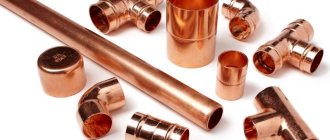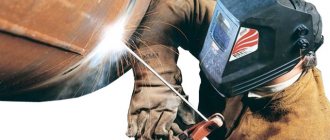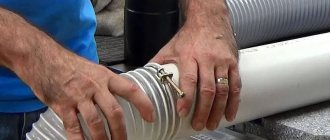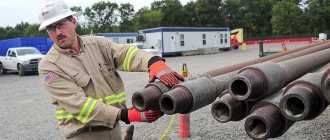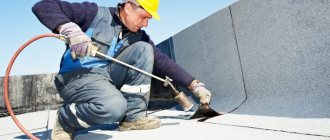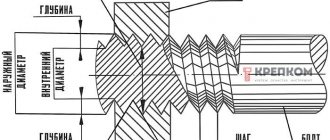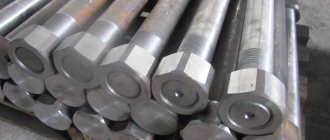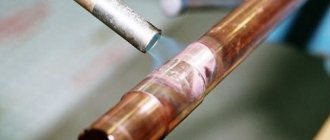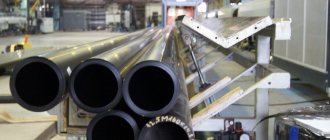Today, there are many options for connecting pipes in pipeline structures. The choice of connection depends on various factors, but the material from which the communication elements are made plays a major role. The second important factor is the type of work environment. It is also worth noting that the operating conditions of the pipeline play a big role.
The connection method is selected depending on the type of pipes, their diameter and the purpose of the future pipeline
Types of connections
All existing pipe connections are divided into two main groups:
- detachable;
- one-piece.
The use of detachable connections allows, if necessary, to disassemble the joint section. Thanks to this property, it is possible to repair and replace the joint without compromising the integrity of the pipes. Detachable joints include threaded connectors (fittings) and flanges.
In the case of permanent joints, it is possible to disassemble the pipeline, however, this will lead to damage to the pipe material. The most popular option for permanently connecting pipelines is welding. In addition, there are a number of other methods: gluing, pressing, installing a socket using cement mortar.
All of the above methods are quite popular and are used to connect pipelines transporting various media: water pipelines, heating communications, gas networks, sewer systems, as well as industrial and technical lines.
Swivel fittings
Separately from all the others, we will look at the rotary corner fitting. What it is?
We have before us a relatively complex element that ensures tightness in a high-pressure system with a movable joint of elements.
Why is this necessary?
There are quite a few examples:
- Hydraulic drives. For example, hydraulic cylinders that lift the bulldozer blade and their connection with high-pressure hoses.
- Fire hoses that can unwind without kinks in any direction from the shield.
- Gas stations with their pistols at every pump.
- Car washes in which water (often with detergents) is supplied through hoses with a movable connection.
Device
In essence, the method of sealing moving joints has been known for a long time. In the simplest version, it is filled with an oil or graphite oil seal. This is exactly how, for example, pump shafts in cold water supply systems are still sealed.
The main problem with oil seals is rapid wear. Pumps, plug valves, screw valves, and other devices require periodic packing.
Modern swivel fittings use materials with much greater wear resistance. To understand how fittings designed for light loads are designed, look inside an open ball valve. In it, the tightness of the moving element with laser surface treatment is ensured by a seal made of wear-resistant plastic with a minimal coefficient of friction.
For high loads (primarily when there is a large force applied to the fitting), it is equipped with rolling bearings. In this case, the wear of the plastic sealing the joint is greatly reduced.
The simplest implementation of an angle swivel fitting. Such a scheme, of course, is not intended for heavy operating loads.
Welded joints
Welding is a very popular method of joining individual parts in a pipeline structure. This method is especially in demand when installing technical communications in factories.
The most commonly used method for installing steel pipelines is hot welding.
It is worth noting that not only individual parts in metal structures, but also plastic products can be connected by welding. In some cases, welding is also used to join glass parts.
Depending on the method of exposure to the material, there are two main methods of such connection:
- fusion welding;
- pressure welding.
Fusion welding has many implementation options:
- electric arc;
- simple electric;
- electrobeam;
- laser;
- gas welding.
The most popular among these options is the first one. The use of electric arc welding implies that the heating source is an electric arc. This type of work can be performed in two ways:
- with alternating current;
- with direct current.
Helpful information! Butt welding of the connected pipeline elements allows the work to be carried out at lower financial costs. This is due to the fact that welding equipment is less expensive and also requires less energy consumption during installation.
Metal welding can be done with electric or gas equipment
This type of installation can be carried out using various equipment, so three types of welding can be distinguished:
- manual;
- semi-automatic;
- automatic.
Types of welded joints
There are different methods for welding individual parts in pipeline communications. Let's look at them:
- end-to-end;
- overlap;
- corner;
- with welding of various elements.
The most popular and common are the following welding connections:
- Butt (longitudinal and transverse). With this welding option, backing elements - rings - can be used. The seam in such joints can be one- or two-sided. The latter is used in cases where the part has a large cross-section - more than 500 mm.
- Angular (one-sided and two-sided). This option can be done in different ways. In some cases, corner joints are welded with an edge bevel, and in others - without it.
- Socket-welded overlap clutch. The socket connection is used to join pipeline elements with a high ductility coefficient. These include parts made of non-ferrous metals, as well as plastic elements.
In addition, square pipes, which are used in construction and the production of various furniture, are also connected by welding. They are not suitable for installation of pipelines. This is due to the shape of their cross-section - it worsens the flow characteristics, while round is the best option for pipeline structures.
Butt welding is used for pipes whose diameter exceeds 50 mm
Operating rules
When connecting pipes using butt welding, the following work procedure :
- Prepare the pipes and clean the edges.
- Lay out the elements on the assembly equipment.
- Center and align the parts to ensure the required gap length.
- Start the joint welding process.
It is necessary to begin welding work immediately after tacking. If the pipe is made of low-alloy pearlitic steel, butt welding should be carried out no later than 4 hours after tack welding.
If the thickness of the parts is more than 5 millimeters, the welding seam must be performed in at least two approaches. Whichever multilayer welding option is used, the joints of the sections must be shifted relative to the lower layers and closed at a specific distance.
For automatic submerged arc welding, at least 50 millimeters are required, for mechanized and manual welding – at least 15 millimeters. Pre-cleaning of residual fragments of fused metal and scale and checking for burns and cracks is carried out.
Resistance welding standards
For such a complex process as butt welding, absolute knowledge and compliance with the rules and requirements is required.
Resistance welding process
The standards according to which pipes are connected are determined according to SNiP 2.04.08-87:
- Installation involves shifting the extreme edges of the pipelines. To correctly calculate this indicator, the formula is used: 0.15S + 0.5 mm, where S refers to the thickness of the pipe walls.
- Contact welding with electrodes and flux is regulated by GOST 16037-80. If the condition of the seams is unsatisfactory, the work must be redone.
- Connecting the edges of pipes is only permitted with chamfers of no more than 5 mm.
- At sub-zero temperatures, assembly and repair of pipelines is prohibited. But if an urgent need arises, it is necessary to heat up the installation materials.
- On wall thicknesses from 6 mm, manual butt welding is performed using a double seam. For smaller sizes one layer is allowed.
- Temporary standards for welding plastic and metal pipelines are based on the material of the pipe. The power of the inverter used for processing also plays a significant role.
Threaded connections
But what to do in cases where it is not possible to carry out welding work? There are quite a few ways to join pipeline elements without welding. The most popular option is threaded installation. Pipe threading is done using cutting machines or an ordinary die. If it is necessary to apply threads to a product with thin walls, use the rolling method.
If you follow all the rules for installing a threaded joint, you will get a durable and sealed structure. Let's consider the main advantages of using such a connection:
- ease of installation.
- the ability to repair or replace without damaging the pipeline;
- installation is carried out without the use of special equipment.
In addition, there are several thread parameters that determine its operation:
- cutting step;
- depth;
- direction.
The pitch determines the distance between the top of the coil and its base. Depth is a parameter that is determined as follows: the distance between the base of the coil and its top is measured. The direction of the thread is an important point; if you ignore it, you may encounter problems when installing the pipeline structure. The thread has two directions:
- right;
- left.
Many types of pipes are equipped with threads; they are used where it is necessary to create a reliable but detachable connection
Installation and replacement rules
Before purchasing the material, I recommend measuring and calculating the required number of pipes and fittings. It is best to draw a wiring diagram directly on the wall, it will be more clear.
In corner joints, one-piece press fittings are usually installed in hard-to-reach places. Crimp quick-release connections, on the contrary, are installed in places with easy access for tightening. They cannot be embedded into walls.
It is important to prepare bends and components for installation. Before installation, check the quality of the fitting and pipe. There should be no damage or signs of delamination on the branch cut. Chips or cracks are not allowed on the connector elements. Be sure to check the suitability of the thread.
Crimp connections often begin to leak due to shrinkage of the O-rings. Repairing the fitting in this case consists of replacing the rings. Typically, two rings are placed in threaded recesses on the device. The unsuitable ones are removed and new ones are put on in their place.
There are some nuances here. The first ring is placed on the top notch. Don't try to lower it lower: this will only damage the rubber. It is enough to pull the second ring along the thread below; it passes freely along the already mounted seal and easily fits onto the lower recess of the fitting thread.
Installation technology
With a threaded connection, the main effort is spent on cutting the threads on the pipe. As a rule, dies are used. Threads are cut on steel pipes with a margin of 1-2 threads. Before screwing, the thread is wrapped with flax strands and lubricated with plumbing paste.
To install a crimp connection, the pipe is cut, the metal-plastic pipe is calibrated, and chamfered. Then put a nut and a crimp sleeve on the outlet and insert the pipe into the angle until it stops, while maintaining the integrity of the o-rings inside the connector. Gently screw the nut on by hand. Then the connection is tightened with an open-end wrench; usually one turn is enough.
Other types of pipe joining without welding
The use of threaded connections is the most popular and widespread method of installing pipeline structures without welding. However, there are other types of pipe connections that are worth paying attention to.
The choice of method, as a rule, depends on the material from which the pipeline is made. All pipes can be divided into two types:
- flexible;
- hard.
The first group includes products that consist of various polymer materials: polypropylene (PP), polyethylene (PE), as well as metal-plastic products. The second group does not have such ductility and includes: steel, cast iron, polyvinyl chloride (PVC), copper, etc.
Important! When installing flexible pipelines, greater coverage of the pipe material is required to ensure a reliable connection than when implementing joints in rigid pipelines.
Types of welding and their differences
Welding is a physical and chemical method of connecting pipeline sections, which forms a hermetically sealed connection between two sections of the structure. This occurs either through fusion or due to plastic deformation under pressure. The technology for forming a weld may vary depending on the type of welding:
- hot;
- cold.
According to the execution method, this process can be:
- manual;
- automatic.
The manual method implies that all stages of welding work are performed by a person. The automatic method is carried out using special machines. With automatic welding, all stages are mechanized and do not require human intervention, however, at the preparation stage, the craftsmen make the necessary adjustments by setting the welding program. The price of such machines is quite high and therefore they are used extremely rarely, as a rule, in large enterprises that perform large volumes of work.
Today there are about 50 types of welding and a huge variety of welding equipment. The most common types today are:
- electric welding;
- cold;
- gas;
- diffuse.
Electric welding requires the use of special equipment powered by electricity.
Electric welding
Today, the use of electric welding is the most popular method. Although a few years ago, primacy was given to gas burners. The popularity of electric welding is due to the simplicity and low cost of the work. It is often called arc or contact. Based on the type of force applied, it is classified as an arc group of thermomechanical work.
To do this kind of work, you will need an inverter or transformer. This equipment performs the following function - it supplies a charge to the electrode. The edges of the element to be welded are processed with an electrode. When materials come into contact, an arc electric charge of enormous power is formed. This reaction is accompanied by the release of high temperatures, which makes it possible to process the pipe.
The layer of coating (coating) of the electrode allows you to maintain special conditions during operation that prevent the flow of oxygen to the melting site.
Let's look at what factors the seam width depends on:
- on the thickness of the electrode;
- on the material of the products being welded;
- welding devices can include different welding modes, which also affects the characteristics of the seam;
- on the speed of the arc and the voltage in the network.
The above parameters determine not only the characteristics of the weld, but also the amount of slag formed during welding.
Important! It is worth remembering that the formed slags must be removed.
Electric pipe welding is considered cheaper than gas welding, however, creating a seam in this way takes more time. Other advantages of electric welding include:
- functionality;
- versatility.
Electric welding cannot be carried out without electrodes, the size of which is selected depending on the type of pipe being processed
Selecting Electrodes
Welds can be different, as a rule, their quality depends on which electrode was used for welding the pipes. The choice of electrode depends on several important factors:
- the material from which the pipe is made;
- pipe cross-section indicator;
- wall thickness.
Helpful information! For thin-walled pipes, electrodes with a thickness of 2–3 mm are used. Welding of thick-walled pipes is carried out using electrodes with a diameter of 4–5 mm.
All electrodes differ depending on the thickness of the coating. The percentage of the mass of the coating to the total mass of the electrode can vary from 3 to 20%. A layer of coating applied to the electrode rod creates the necessary environment in which the process takes place without access to oxygen. There is a certain pattern - the amount of slag that affects the quality of the seam depends on the thickness of the coating layer.
When choosing an electrode, it is necessary to take into account all of the above parameters. To obtain a high-quality seam, you should pay attention to many factors that affect the compatibility of different types of electrodes with pipes.
Cold welding
Cold welding for pipes is regulated by relevant documentation and is a method of obtaining permanent, hermetic connections. This method eliminates heating of the parts being welded, and the joining itself is performed due to deformation. Cold welding is carried out due to the pressure exerted on the parts. As a result of such welding, the oxide layer is destroyed and the connection is made at the atomic level (atomic diffusion).
Cold welding is carried out using special equipment in industrial conditions
This welding is divided into three types depending on the technology:
- point;
- suture;
- butt.
Cold spot welding is carried out using a punch. A punch is a device that presses materials. The second type, seam welding, is performed in two ways: welding along the entire length and making welded points, which subsequently form a continuous seam. The butt version is performed due to strong compression of the elements secured in the clamps.
Let's consider the main areas of use of the cold method:
- connection of parts made of the same metal;
- production of rolled metal, which has several layers of different metals;
- when reinforcing aluminum wires. The reinforcement is made with copper.
The cold welding method is quite popular today. Its popularity is due to the following advantages:
- During cold welding, deformation of metal parts is eliminated. This is due to the fact that the workpieces are not heated ;
- Using this method allows you to obtain a very neat seam, characterized by high strength and tightness. In addition, it does not require additional processing;
Note! There are cases when cold welding is the only way out of the situation. For example, joining aluminum and copper can only be done by cold welding.
- after completing such a process, there is no waste left (residues of electrodes, metal splashes, etc.);
- work is carried out without the use of electricity;
- This method, among other things, is environmentally friendly, since the work is carried out without the release of toxic substances, as well as without radiation harmful to human eyes.
- the ability to connect large areas using explosion welding.
Gas welding allows you to get the most aesthetic seam at the junction of parts
Gas welding
Connecting different types of pipes using a gas burner is a very old, but also reliable way of installing communications. For these purposes, special gas burners are used that are capable of heating the pipe to high temperatures.
Due to the heating of the edge with the connecting wire, it quickly reaches the melting temperature. As a result, the metal floats on top of each other and a strong, permanent connection is obtained that is resistant to mechanical stress.
Let's consider the main advantages of using gas welding for the installation of pipelines of various directions:
- high efficiency of the method;
- using a gas torch allows you to get a neat, high-quality seam;
- the process is not particularly complicated;
The disadvantages of this method include:
- work with a gas burner should only be carried out by a specialist who has certain skills in this area;
- Gas welding is a rather expensive method, as expensive resources are used.
Diffuse welding
All previous pipeline welding methods are used to connect metal pipes, but today such products compete with plastic parts in the construction market. To connect individual elements of plastic communications, a special method is used, which has gained great popularity - diffuse welding.
Diffuse welding is a method of joining polymer pipes - polypropylene, PE and others
The main advantages of such welding include:
- obtaining an aesthetic seam;
- minimum required tools;
- high installation speed;
- attractive price.
To obtain a permanent connection between two plastic pipes, special devices are used that heat the plastic. Such devices are equipped with various attachments. All nozzles have their own diameter, suitable for the cross-sectional dimensions of a particular pipe.
Let's consider the main stages of connecting two plastic pipes using such a device:
- Based on the diameter of the pipes being connected, the required nozzle is selected.
- Pipes are laid inside the device.
- The pipe material is heated and their ends are compressed inside the apparatus.
- After the connecting seam is formed, the device turns off.
After a few hours, the resulting connection can already be used . This method is quite simple and fast, and the pipe welding line is durable and neat.
Connecting flexible pipes without welding
Often, in order to install a pipeline without the use of welding equipment, special connecting elements - fittings - are used. Fittings for flexible pipes must have a large reach to make a reliable and airtight joint.
Compression fittings allow you to create a tight connection without welding or threading
As a rule, fittings are used in flexible pipelines that have small or medium cross-sections (from 20 to 315 mm). For parts with a diameter above 315 mm, a fitting joint is not practical. This is due to the fact that the reliability of such a connection is quite low.
For joining low-pressure polyethylene (HDPE) products, special compression fittings are mainly used. The joining of individual elements in a pipeline structure using compression products allows for quick installation, which is also inexpensive and simple.
However, compression products are most often used to connect small diameter pipes. Medium-diameter pipes are connected using couplings. The coupling is perhaps the most common fitting option.
Gas welding technique
The essence of the process is heating the ends of the joined elements in the flame of a gas-oxygen mixture while simultaneously filling the space between the joined parts with the substance of a specially melting metal rod.
Despite the sufficient reliability of this method, the strength and other mechanical properties of the resulting weld will be worse than after electric arc welding. However, this particular method is used when it is necessary to connect small elements, for example, pipes with small diameters and thicknesses, up to 3.5 mm.
Connecting rigid pipes without welding
As mentioned above, inelastic pipes are often joined using threads. But there are methods that allow you to connect individual elements of rigid pipelines without the use of welding and threading. Docking without welding equipment is permitted on parts with a diameter of up to 600 mm.
If it is not possible to cut a thread on a rigid pipe or use welding for joining, then the pipeline is mounted using couplings
In order to install a rigid structure without the use of welding equipment, couplings are usually used. The coupling joint allows you to connect the following pipe options:
- equal in diameter;
- with different diameters;
- from various materials.
The connection obtained using such a fitting is characterized by high strength characteristics and good tightness. If it is necessary to connect two pipes without welding and threading, as a rule, special devices are used - flanges. They are also widely used for connecting various equipment to pipes.
Flange connections are recommended for use in cases where a specific section of the pipeline requires frequent inspections or periodic repairs. This is due to the fact that such a clutch is easy to disassemble and reassemble. It includes:
- two connecting flange elements;
- sealing ring;
- nuts and bolts.
Steel water and gas pipes
Threaded fittings
This is the most traditional and familiar solution. It was on elements of this type that water supply and heating systems were assembled at the beginning of the twentieth century.
By the way, the author had the opportunity to disassemble heating risers in Stalin buildings, assembled on galvanized cast-iron corners; both the pipes and the fittings themselves were in perfect condition after half a century of use. It must be admitted that the combination of galvanized steel pipes with threaded fittings is an extremely reliable and durable connection method.
What are they? Actually, the choice of shapes is small: corners are available with external and internal threads, as well as with a combination of both types. It is not difficult to find adapter angles from one diameter to another on sale.
Several options for making threaded corners.
Material
Threaded angles are made from:
- Cast iron . The most reliable and durable material (primarily due to the large wall thickness, which compensates for the fragility of cast iron). Does not stick to steel pipes and can be easily dismantled even after decades of use.
- Brass (sometimes chrome plated). The walls are thinner, therefore the strength is somewhat less. When assembling, avoid excessive force.
- Black steel . Corrosion and boiling of threads are problems with this material. The advantages include the highest strength: steel angles can be safely used, for example, in high-pressure hydraulic systems.
- Stainless steel corners do not have the problems of black steel; at the same time, they fully possess its strength. The price of such products, however, is quite high.
- Finally, Chinese products made from silumin (powdered metal) are extremely cheap; but it's absolutely not worth buying them. About half of this type of fittings are destroyed during assembly.
As you can see, silumin is not the best choice.
Peculiarities
- Cutting threads for these fittings with your own hands is a rather labor-intensive process. In addition, you will have to very accurately measure the length of the pipes and the number of threads: tension installation will most likely lead to damage to the corner.
- Threads on plumbing and heating pipes require sealing. The winding is wound before assembly along the thread. The best options are plumbing linen with paint or sealant and a polymer sealing thread.
Please note: FUM tape is not the best choice for sealing threads. With minimal reverse movement (for example, when trying to set the valve in a convenient position), the connection sealed by it begins to leak.
Compression fittings
They are less common, but often help out in problematic cases.
Which ones exactly?
- Sometimes it is difficult to get to the pipe for threading. You don’t always want to break a section of floor or wall just for one threaded connection.
- Thin-walled pipes, after cutting threads in their cavities, become so thin that their operation under pressure is simply dangerous.
- Finally, if for some reason it is impossible to replace a section of pipe that is noticeably damaged by corrosion, a compression fitting will help out here too. Trying to thread a rusty pipe will most likely result in its destruction.
How are the elements that interest us arranged? Inside the brass or plastic body is a silicone or rubber O-ring; when, with a steel pipe inserted inside, it is clamped with a fixing nut, the seal tightly compresses the steel surface. This ensures both mechanical fixation and complete tightness.
Tee with two compression and one threaded connections.
There are features here too.
- Unlike threads, it is quite possible to break such a connection with a strong enough jerk.
- The pipe needs to be thoroughly cleaned of the surface from the slightest irregularities, rust and paint.
Non-standard methods of connecting pipes
In addition to the traditional methods of joining pipes, which are the most common, there are also some special installation methods. Pipes can also be made of non-standard material, which requires a special connection.
Sockets are most often used to connect sewer systems
Let's consider the following docking methods:
- gluing;
- bell joint;
- quick connectors.
The first option is used if the structure is made of plastic. The gluing method allows you to obtain a strong and hermetically sealed permanent connection. Joining pipes in this way is done by applying a special glue to them.
The socket connection is used, as a rule, when installing non-pressure sewer systems. In such systems, wastewater moves naturally at an angle, without the use of a special pump. Depending on what material such a pipeline is made of, there may be a detachable or permanent socket connection. The detachable version of the socket coupling is used when installing plastic communications, and the one-piece version is used when installing cast iron pipes. The socket is sealed in cast iron structures using a cement composition or special sealants.
Helpful information! Quick-release or quick-release connections are installed if the operational features of the communication require its frequent disassembly.
Let's look at the main options for quick-release connections:
- clamps equipped with a fixing wedge;
- cam (Camlok);
- ISO connection.
Flexible pipes and hoses can be connected using quick connect fittings such as Camlok
These clutch options are easy to install and have good strength characteristics.
It is also worth noting that for joining pipes that are used for industrial purposes, the following joints are used:
- nipple;
- telescopic;
- articulated.
The first option is used in cases where it is necessary to connect pipes with any measuring equipment, and the second - when joining rigid pipes equipped with flexible elements. The hinged type is used in the construction of highways with complex shapes. This connection allows you to compensate for the effect of twisting the pipeline.
Cross-linked polyethylene
Device
The material is a specially processed modification of ordinary polyethylene, differing from it in a number of properties:
- Greater mechanical strength;
- Higher melting point;
- More pronounced spatial molecular memory.
The last property is used when making fitting connections. A plastic or brass fitting for a HDPE pipe is an ordinary fitting with a locking ring that slides over it.
Corner for cross-linked polyethylene. The fitting is simple, cheap and provides an extremely reliable connection.
How is the connection made?
The instructions are quite simple:
- The retaining ring is put on the pipe in advance and is shifted away from its edge.
- A special tool, an expander, is inserted inside the end of the pipe. In several stages, plunging deeper and deeper, he stretches the end of the pipe.
- The stretched pipe is put on the fitting. After a short time, thanks to the notorious molecular memory, it becomes tightly compressed.
- The end of the pipe is additionally secured at the top by a pushed-in locking ring.
Corner fittings for cross-linked polyethylene, in fact, are the described fittings of different diameters, at different angles to each other and in arbitrary combinations with threads, valves and chokes.
Peculiarities
The connections are strong and practically inseparable. If it is necessary to remove the pipe from the fitting, the easiest way is to simply cut it off and, displacing the retaining ring, cut off the polyethylene from the fitting layer by layer.
Pipes made of cross-linked polyethylene are sold in coils up to 500 meters long and have not only strength, but also excellent flexibility. This makes them an ideal material for manifold water distribution, heating in screeds and for installing water heated floors.
The only negative point is the cost of the expander for making connections with fittings. It starts from 15 thousand rubles for the simplest products. However, no one canceled the rental of instruments.
This seemingly simple tool costs 20,245 rubles.
Features of connecting profile pipes
Profile pipes have good strength and relatively low weight, so they are often used for the installation of frame structures, as well as for other construction purposes.
The shape of profile pipes can be:
- rectangular (the most common shape);
- square;
- ovoid (oval);
- others (more complex forms).
The most reliable way to create structures from profile pipes is to fasten them by welding
Electric arc welding is usually used to connect square pipes. There are also special connections that are made using bolts and rivets. Square and rectangular pipes are joined using the same methods.
In addition, various parts can be joined to such pipes. This joining is carried out using self-tapping screws. These elements do not require preliminary holes.
Advantages and disadvantages
Advantages of corner fitting:
- Allows you to avoid the time-consuming and costly operation of bending a pipe, and in many cases successfully replaces it.
- With its help, a reliable connection is created that will last the entire life of the system.
- Fitting connections are easy to install, do not require welding or highly qualified installers.
- Low cost.
Experts include the following disadvantages:
- Possibility of leaks due to improper installation or defective products.
- Susceptibility to mechanical influences (shocks, vibrations).
Connecting profile pipes without welding
Joining of profile pipes can be carried out without the use of welding equipment. How to connect profile pipes without welding:
- use of a crab system;
- fitting connection.
The crab system for pipes consists of connecting brackets and fixing elements. The connection in this case is made using nuts and bolts and ultimately forms an “X”, “G” or “T”-shaped profile structure. With this connection you can connect from 1 to 4 pipes, but only at right angles. They are as strong as welded seams.
A fitting connection is used when it is necessary to make a branch from the main pipe. There are several types of pipe connectors that allow you to mount workpieces in different configurations. The main ones:
- coupling;
- corner;
- tee;
- cross.
Crab systems are most often used when installing simple outdoor structures, such as a greenhouse or shed
How to connect pipes from different materials?
In some cases, it is necessary to connect products that are not homogeneous in material. There are special options for these purposes.
How to connect a polypropylene (plastic) pipe to a metal one?
Many people ask the question: how to connect polypropylene pipes with metal ones? There are several popular methods for this:
- thread;
- flange pipe connection.
In the first case, the coupling of pipes of heterogeneous material is carried out using couplings. One end of such a coupling is equipped with a thread, and the other has a smooth surface for joining with polypropylene.
The flange method involves the use of flanges. This connection is made using studs and bolts.
Note! Flanges are used in structures that are often disassembled during operation.
How to connect metal-plastic pipes with metal ones?
The most popular options in this case are:
- press fittings;
- compression fittings.
In the first case, the connection between pipes of heterogeneous material can be made in two ways:
- sliding press fitting;
- crimp coupling.
It is important to remember that connecting metal-plastic pipes with metal and other pipes of heterogeneous material is quite a responsible undertaking and should be carried out by specially trained specialists. Incorrect installation of the connecting element will lead to an emergency in the pipeline.
Metal-plastic
There are two types of fittings for connecting metal-polymer pipes.
Compression
Device
The element intended for connection to the pipe consists of a fitting with rubber sealing rings, a split ring and a union nut. Material: brass (with or without chrome plating).
The connection is made like this:
- The pipe is calibrated (its end part is given a perfectly round shape).
- A chamfer is removed from the inner surface of the pipe end.
- The union nut is pressed onto it, then the split ring is put on.
- The fitting is inserted into the pipe until it stops.
Important: try not to dislodge the rubber rings while doing this. They should remain between the fitting and the pipe.
- The split ring is driven to the very edge of the pipe.
- The union nut fits onto the thread and is tightened with moderate force, squeezing the ring inside and squeezing the pipe onto the fitting through it.
And here we see all sorts of transitions to different diameters of metal-plastic, threaded connections and other types of pipes.
Some fittings of this type are presented here.
Peculiarities
Connections are made extremely easily with an absolute minimum of tools; however, this type of fittings should not be used for hot water and heating. After several heating and cooling cycles (especially if the rubber seals have become dislodged), the connections begin to leak. However, the leak can be stopped by re-tightening the union nut.
Press fittings
Connections using them are free of the problem described above. Instead of a split ring and a union nut, the pipe is fixed to the fitting by crimping a wide locking ring. Press fittings can be safely used for heating; however, installation in this case will require a special tool.
These elements can be safely used for heating and hot water.
